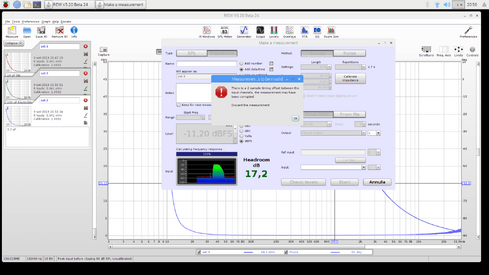Antonio Di Motta
Member
Good evening Mr. Jhon, I would like some advice on how to improve the accuracy of the impedance measurement.
I have created a measuring instrument based on its REW software and i am currently realizing a second release of the instrument with the best precision and extent of measurement.
To make measurements with good precision, i use a high impedance buffer at the input of the sound card with a multi-turn adjustment trimmer in order to perfectly balance the level between
the right and left channel so as not to have to do the software calibration of REW.
Before making the impedance measurement of a device (passive component) I measure the output cable in short and the output cable open to check the impedance at zero ohms and in theory infinite
(in practice, about input impedance of the buffer ).
Precisely the open circuit measurement creates some precision problems on the measurement since it is very variable and I can't give myself an explanation as to why this behavior.
I attach the files so that I can also see the current accuracy of the measurement.
Thank you for everything and congratulations on your beautiful software that allowed me to build the ideal tool for my electro-acoustic projects.
I have created a measuring instrument based on its REW software and i am currently realizing a second release of the instrument with the best precision and extent of measurement.
To make measurements with good precision, i use a high impedance buffer at the input of the sound card with a multi-turn adjustment trimmer in order to perfectly balance the level between
the right and left channel so as not to have to do the software calibration of REW.
Before making the impedance measurement of a device (passive component) I measure the output cable in short and the output cable open to check the impedance at zero ohms and in theory infinite
(in practice, about input impedance of the buffer ).
Precisely the open circuit measurement creates some precision problems on the measurement since it is very variable and I can't give myself an explanation as to why this behavior.
I attach the files so that I can also see the current accuracy of the measurement.
Thank you for everything and congratulations on your beautiful software that allowed me to build the ideal tool for my electro-acoustic projects.
Attachments
-
Impedenza_circuito_aperto.mdat4 MB · Views: 79
-
Impedenza_circuito_chiuso.mdat4 MB · Views: 233
-
Impedenza_resistenza_test_10ohm.mdat4 MB · Views: 89
-
Impedenza_resistenza_test_111ohm.mdat4 MB · Views: 632
-
Impedenza_resistenza_test_150ohm.mdat4 MB · Views: 129
-
Impedenza_resistenza_test_300ohm.mdat4 MB · Views: 115















